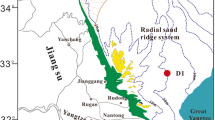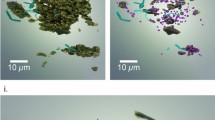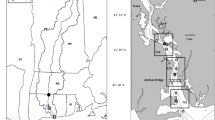Abstract
Natural flocs in an estuary grow with increasing time, salinity, suspended particulate matter concentration, and with decreasing turbulence. Although various theoretical and empirical functions for floc growth have been proposed in the literature, they are all complex. It is argued in this study that there should be a simple and general function of floc size D against time t, salinity S, suspended particulate matter concentration C, microscale η, and biochemical composition M. Theory and experiments seem to corroborate that average floc size responds systematically to its drivers. Moreover, the response is partly similar to all drivers: a lower plateau followed by a rise, and partly different: an upper plateau for t, S and a fall for C, η. Assuming drivers are independent, each curve is normalized around its rise. The drivers are joined into one variable X that holds each normalized driver with equal weight. The result is a function that gives floc size against this composite variable X. This composite variable in turn is a function of ambient conditions and the function predicts floc size for any set of ambient conditions. The case is presented here using linear segments, but eventually the logistic growth function is proposed.
Similar content being viewed by others
References
Dupont JP, Wang H-Q, Lafite R, Meyer R, Texier H (1995) Granulométrie et vitesse de chute des matières en suspension en estuaire de Seine Surface Geosciences (hydrology-hydrogeology). C R Acad Sc., Sér. 2 320:961–968
Eisma D (1986) Flocculation and re-flocculation of suspended matter in estuaries. Neth J Sea Res 20:183–199
Fennessy MJ, Dyer KR (1996) Floc population characteristics measured with INSSEV during the Elbe estuary intercalibration experiment. J Sea Res 36(1–2):55–62
Gibbs RJ, Tshudy DM, Konwar L, Martin JM (1989) Coagulation and transport of sediments in the Gironde estuary. Sedimentology 36:987–999
Kolmogorov AN (1941a) The local structure of turbulence in incompressible viscous fluid for very large Reynolds numbers. Dokl Akad Nauk SSSR 30:301
Kolmogorov AN (1941b) Dissipation of energy in locally isotropic turbulence. Dokl Akad Nauk SSSR 39:16
Kranenburg C (1994) The fractal structure of cohesive sediment aggregates. Bull Estuar Coast Sci Assoc 39:451–460
Krone RB (1963) A study of rheological properties of estuarial sediments. Technical Bulletin 7, USAE Communication on Tidal Hydrodynamics
Krone RB (1986) The significance of aggregate properties to transport processes. In: Mehta AJ (ed) Estuarine cohesive sediment dynamics. Springer, Berlin, pp 66–84
Lick W (1994) Modelling the transport of sediment and hydrophobic contaminants in surface waters. In: United States of America/Israel workshop on monitoring and modelling water quality, Haifa
Maggi F (2005) Flocculation dynamics of cohesive sediment. PhD thesis, University of Technology Delft, Delft, 136 pp
Manning AJ (2001) A study of the effects of turbulence on the properties of flocculated mud. PhD thesis, University of Plymouth, Plymouth, 282 pp
Manning AJ, Dyer KR (1999) A laboratory examination of the characterisation with regard to turbulent shearing. Mar Geol 160:147–170
Mietta F, Chassagne C, Manning AJ, Winterwerp JC (2009) Influence of shear rate, organic matter content, pH and salinity on mud flocculation. Ocean Dyn 59(5):751–763
Migniot C (1977) Action des courants, de la houle et du vent sur les sediments. Houille Blanche 1:9–47
Mikeš D, Manning AJ (2010) An assessment of flocculation kinetics of cohesive sediments from the Seine and Gironde Estuaries, France, through laboratory and field studies. J Waterw Port Coast Ocean Eng 136(6):306–318
Mikeš D, Verney R, Belorgey M, Lafite R (2004) Controlling factors in estuarine flocculation processes: experimental results with material from the Seine Estuary, Northwestern France. In: Ciavola P, Collins M (eds) Sediment transport in European estuarine environments. J Coast Res Special Issue 41:82–89
Milligan TG (1995) An examination of the settling behaviour of a flocculated suspension. Neth J Sea Res 33(2):163–171
Mouchel J-M (1997) Flocculation et sédimentation dans l’estuaire de la Seine. In: Rapport d’activité Seine Aval, pp 137–173
Richards FJ (1959) A flexible growth function for empirical use. J Exp Bot 10:290–300
Uncles RJ (2002) Estuarine physical processes research: some recent studies and progress. Estuar Coast Shelf Sci 55:829–856
van Leussen W (1994) Estuarine macroflocs: their role in fine-grained sediment transport. PhD thesis, University of Utrecht, 488 pp
Verney R (2002) Les mecanismes de la flocculation dans les milieux naturels estuarines, cas de l’estuaire de la Seine. Université d’Aix Marseille II, Marseille, 36 pp
Verney R (2006) Processus de controle de la dynamique des sediments cohesifs; mesures in situ, experimentales et modelisation; application a l’estuaire de la Seine. PhD thesis, Université de Rouen, Rouen, 323 pp
Winterwerp JC (1998) A simple model for turbulence induced flocculation of cohesive sediment. J Hydraul Res 36(3):309–326
Winterwerp JC (2002) On the flocculation and settling velocity of estuarine mud. Cont Shelf Res 22:1339–1360
Winterwerp JC, Manning AJ, Martens C, Mulder TD, Vanlede J (2006) A heuristic formula for turbulence-induced flocculation of cohesive sediment. Estuar Coast Shelf Sci 68:195–207
Author information
Authors and Affiliations
Corresponding author
Rights and permissions
About this article
Cite this article
Mikeš, D. A Simple Floc-Growth Function for Natural Flocs in Estuaries. Math Geosci 43, 593–606 (2011). https://doi.org/10.1007/s11004-011-9342-9
Received:
Accepted:
Published:
Issue Date:
DOI: https://doi.org/10.1007/s11004-011-9342-9




